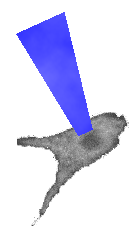Neuroscience For Kids
Optogenetics: Shedding Light on Monkey Behavior
Allison A.
Curley, Ph.D., Neuroscience for Kids Guest Writer
 August 22, 2012
August 22, 2012
For the first time, thanks to a cutting-edge technique called "optogenetics," neuroscientists have been able to change the behavior of monkeys simply by shining blue light onto their brains.
Amazing algae
Optogenetics relies on a remarkable class of light-activated proteins called channelrhodopsins that are found in some types of algae. Channelrhodopsins are ion channels, meaning that they control the flow of ions into and out of the cell. Shining intense light onto a channelrhodopsin opens the channel, allowing ions to flow across the cell membrane and causing the neuron to fire an action potential. When the light is turned off, so is the neuron. Using genetic techniques, scientists can insert these proteins into the neurons of laboratory animals. By implanting a fiber-optic cable that penetrates the skull, light can be applied to the brain when an animal is awake and moving around, making it possible to study how its behavior changes when specific neurons are activated.
Optogenetics has revolutionized the field of neuroscience in the last decade. Unlike other methods that use drugs or electrical stimulation to activate neurons, channelrhodopsins can be inserted into specific types of neurons or brain regions, and turned on for very precise amounts of time. This allows researchers an unparalleled level of control. Optogenetics is currently being used in laboratories all over the world to develop a better understanding of brain function.
Monkey Blue, Monkey Do
In a recent study by researchers in the United States and Belgium, optogenetics was used to alter the behavior of monkeys to examine a specific type of quick eye movements known as saccades. After inserting a form of channelrhodopsin that is activated by blue light into areas of the frontal lobe known to control these eye movements, the scientists trained the monkeys to perform a task that required them to make saccades to a target on a computer screen.
When the light was on, the monkeys made saccades to the target faster than when it was off. So, by activating the neurons that control saccades, the scientists were able to speed up the monkeys' eye movement behavior.
Optogenetics has been used to control mouse behavior in past studies, but the current one was the first to succeed in the larger and more complex brain of primates. Because monkeys are closer relatives of humans than mice, this new research brings neuroscientists one step closer to the goal of using optogenetics to improve neuron function as a treatment for human illnesses like Parkinson's disease and depression.
References and further information:
- Gerits, A., Farivar, R., Rosen, B.R., Wald, L.L., Boyden, E.S., Vanduffel, W. Optogenetically induced behavioral and functional network changes in primates, Current Biology, 22: 1-5, 2012.
- Method of the Year - 2010: Optogenetics by Nature video
Copyright © 1996-2012, Eric H. Chudler, University of Washington
